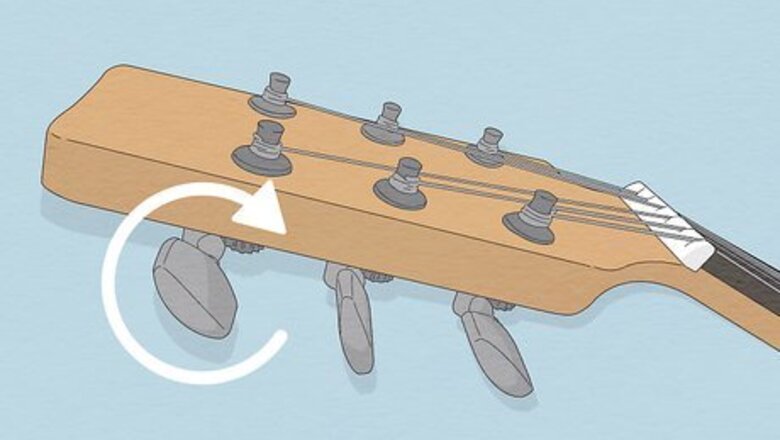
views
Adjusting the Peg Tension
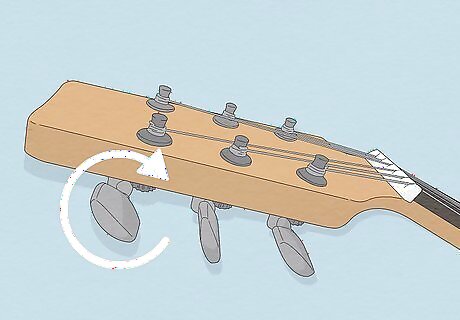
Rotate the peg clockwise to loosen the string until it’s slack. If you leave your string as is, it could snap or break if you accidentally tighten the peg during your repair. Lay your guitar flat on a stable surface so the pegs face you. Rotate the tuning peg you’re working on clockwise until you don't feel any more tension on the string. You can also remove the string completely from your guitar if you want, but it’s not required for this fix.

Tighten the screw at the end of the peg by turning it clockwise. Locate the screw sticking out from the end of the tuning peg, which controls how easily you can turn it. Hold the tuning peg still with your non-dominant hand and fit a Phillips-head screwdriver into the screw. Rotate the screw clockwise by a quarter turn at a time so you don’t accidentally overtighten the peg. If your tuning pegs don’t have screws on the end, then this repair won’t work for your guitar. Conversely, if your tuning peg feels too tight, try turning the screw a quarter turn counter-clockwise instead.

Turn the peg to test if you feel slight tension. Your tuning peg shouldn’t feel loose, but it also shouldn’t feel too tight. Try spinning the peg by hand to see if there’s a small amount of resistance. As long as the peg stays in place after you turn it and you can still easily make adjustments, then you can move on to the next step. If the tuning peg still feels too loose, rotate the screw another quarter turn and test it again. Be careful not to overtighten the tuning peg since you could damage the tuner or stock of your guitar.
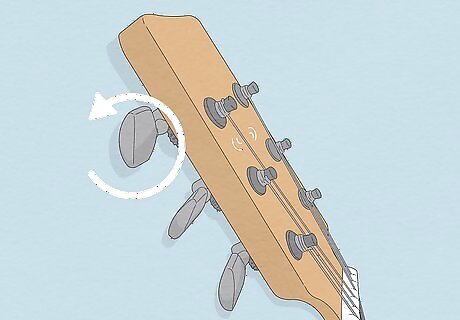
Spin the peg counterclockwise to put tension back on the guitar string. Hold onto the peg and turn it counter-clockwise so the string tightens up again. As you add tension back to the string, strum it a few times to check the pitch. Use a tuner to ensure your string plays the correct tone for the overall tuning you’re using for your guitar. If you accidentally tune the string too high, rotate the peg clockwise by a half turn to lower the note. Slowly tune back up to your desired note to help keep your strings tight.
Tightening Loose Tuning Pegs

Loosen the strings off of the pegs by turning them clockwise. Rotate the tuning pegs clockwise so the strings loosen up and have some slack. If you want to save your strings, loosen the pegs enough until you can unwrap and slide the strings out from them. If you plan on installing brand new strings, then you can use a pair of wire cutters to clip the strings before pulling them out. Avoid trying to unwrap or cut the strings if they still have tension since they could snap up and hurt you.
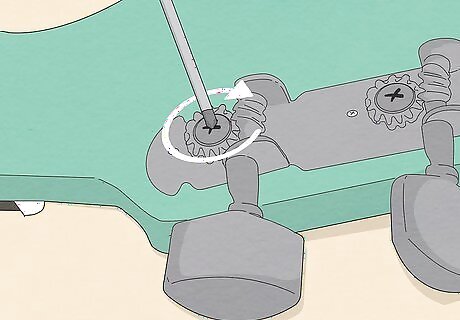
Screw the mounting screws clockwise to ensure they’re tight against the stock. Lay your guitar upside-down on a table so you can see where the tuning pegs mount to the back of the stock, which is the piece at the end of the neck. Locate the small mounting screws along the edges of the pegs to see if any of them feel loose. Use a Phillips-head screwdriver to turn the screws clockwise until they’re tight. Avoid overtightening the screws so you don’t accidentally damage your guitar’s body. You might find the screws on the side of the guitar if that’s where the tuning pegs are mounted.
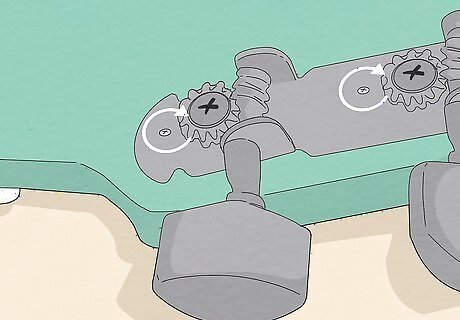
Turn the screw on an open tuner’s gear clockwise if it wobbles. While most modern tuning pegs have covers, some acoustic and classical guitars leave the gears exposed. If you notice the gear shifting back and forth, fit a Phillips-head screwdriver in the screw in the center. Rotate the screw clockwise until it feels tight against the stock. Adjusting the tightness on the gear will not affect the tension when you turn the peg.
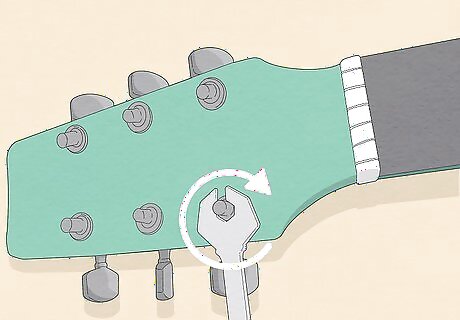
Use a wrench to turn the nut on the front of the stock clockwise if it feels loose. Some guitars have a nut on the front that holds the tuning peg in place. Flip your guitar over so it’s face-up and fit a wrench around the peg’s nut. Rotate the nut clockwise by a quarter turn and check if it still feels loose. Keep screwing the nut on tighter until the peg doesn’t move around anymore. Your guitar might not have nuts on your tuning pegs.
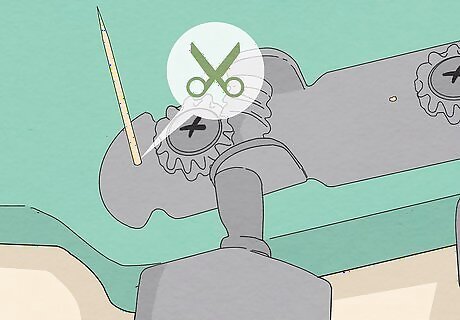
Fill the mounting screw’s hole with a toothpick if the tuner still isn’t secure. Unscrew the mounting screws on the tuner and take them off of your guitar. Coat a toothpick with wood glue and push it as far as you can into the mounting screw's hole. Use a utility knife to cut off any excess toothpick still sticking out. Place the tuner back into position and screw it back in. The toothpick adds extra tooth for the screw to hold onto so it’s less likely to slide out or feel loose.
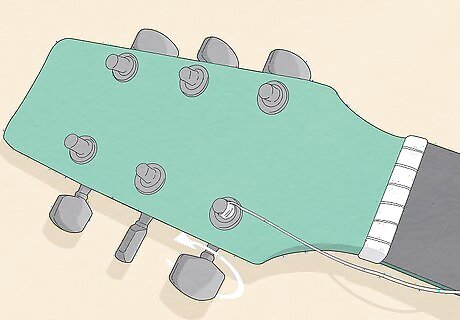
Reinstall the strings on your guitar. Keep the string slack and feed the end straight through the hole in the tuning peg. Turn the peg counter-clockwise so the string wraps around it above the hole. Guide the string underneath the wrapped section and turn the peg another full rotation. Tune the string to the correct note and trim off any excess string with a pair of wire cutters. Avoid over wrapping the string around the peg since it could affect the overall tone of your guitar.
Lubricating Stiff Pegs
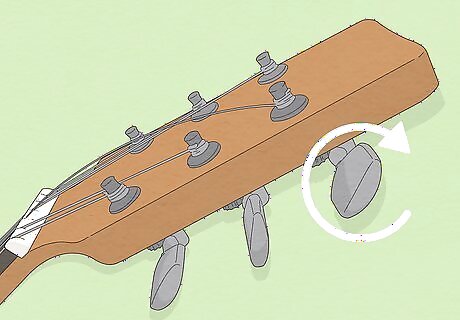
Remove the strings by turning the pegs clockwise. Take tension off of the strings by turning them clockwise. If you plan on reusing the strings, keep turning the peg until you can easily pull the strings out from the tuning pegs’ holes. If you plan on using new strings, use a pair of wire cutters to slice through the strings before pulling them out. You can leave the strings attached to the bottom of your guitar if you don’t want to remove them completely. That way, they’re easier to reinstall.
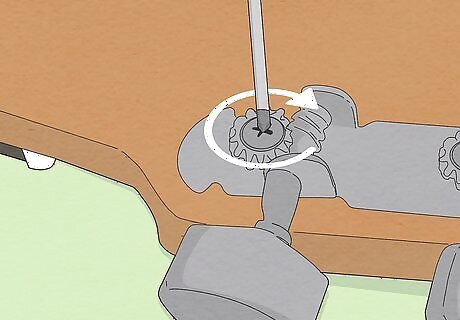
Unscrew the tuning pegs from the stock. Flip your guitar over so you can access the mounting screws holding the pegs to the stock. Use a Phillips-head screwdriver to turn the screws counterclockwise until they’re loose. Carefully lift the pegs out of the holes in the guitar’s stock and set them aside. You may also need to loosen nuts on the front of the peg if your guitar has them. Avoid cleaning and lubricating your tuning pegs while they’re still attached since you could damage the body of your guitar.

Scrape out dirt and dust with a clean toothbrush. Take a soft-bristled toothbrush and gently scrub the tuning peg. Apply light pressure as you work over any areas where the peg and gear are exposed. Try to get as much buildup off of the peg as you can. Make sure you only use the toothbrush for cleaning purposes.

Clean off stuck-on material with a cloth soaked in WD-40 or naphtha. Spray some WD-40 on a shop cloth and carefully wipe the surfaces of the peg and gear. Turn the peg while you’re working to help spread the WD-40 throughout the whole mechanism. If your peg still doesn’t move very easily, fill a small dish with some naphtha, which is a type of oil, and let the tuning peg soak for about a minute to help loosen up the gunk. If you’re working with a tuning peg with an enclosed gear, then use a pipette to spray the WD-40 or naphtha into the opening at the bottom of the peg. If you use naphtha, work in a well-ventilated area with protective gloves. Naphtha can cause nose, throat, and skin irritation and is extremely flammable.

Squirt a multi-purpose lubricant onto the tuning gear. Place the tip of the lubricant nozzle into the small hole near the bottom of the peg or directly onto it. Squeeze a few drops of the lubricant onto the tuning peg and gear so it coats the surface. You can use any mechanical lubricant, but you might find some specific for guitars at a music store.
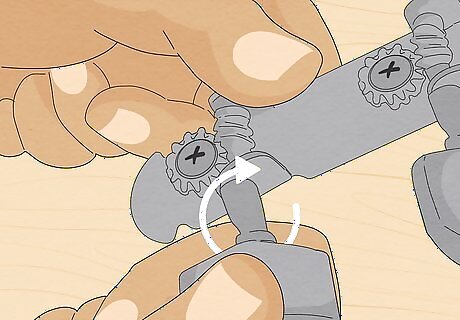
Turn the peg to evenly spread the lubricant. Hold onto the body of the tuner with your non-dominant hand and rotate the peg in either direction. The lubricant will work along the peg’s threading and into the teeth of the gear so it’s easier to spin and make adjustments.

Reattach the tuning pegs and strings. Place the tuning peg back against the guitar’s stock and screw it back into the mounting holes so it fits tightly. Feed the end of the string through the peg’s hole and turn the peg counterclockwise to tighten it again. Wrap the string around the peg about 2–3 times before trimming off any of the excess.
Replacing the Tuners
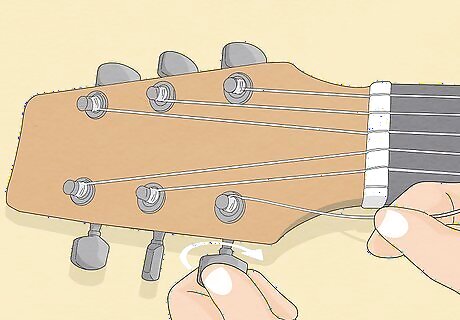
Turn the peg clockwise to loosen and remove the string. Rotate the peg as far clockwise as you can to put slack on the string. If you want to save the string, keep turning the peg until you can easily slide the string out. If you’re planning on putting in a new string along with your new tuner, then you can just cut the string with a pair of wire cutters and pull it out. Always take tension off of the string before you cut or remove it. Otherwise, it could spring up and hurt you.

Unscrew the mounting screws on the back of the tuner. Flip your guitar over to expose the small mounting screws on the back of the peg. Use a Phillips-head screwdriver to turn each of the screws counterclockwise until they’re loose enough to pull out. Each of your tuning pegs will usually have 1–2 screws, so be sure to remove them all. New tuners usually come with new mounting screws, so you don’t have to save the old ones. Some classical or acoustic guitars will have mounting screws on the side of the guitar stock instead of on the back.

Pull the peg out from the back of the guitar’s stock. Grab the back of the tuning peg and slide it straight out from the hole in your guitar. Be careful not to bend it or pull it out at an angle so you don’t damage the body of your guitar. You can throw away the old peg as soon as you remove it. If your peg doesn’t slide out easily, it might be held in by a nut on the front of the guitar stock. Use a wrench to loosen the nut.

Feed a new tuning peg through the hole in the back of the guitar. Get tuners that are the same sizes as your old ones so they fit in the existing holes. Slide the peg into the hole and press it tightly against the back of the guitar’s stock. Line up the screw holes on the guitar with the ones on the tuning peg to make it aligned. You can buy tuning pegs online or from a local music store.

Rotate the mounting screws clockwise to secure the tuner. Feed the mounting screws through the holes in the tuning peg and into the holes in the back of your guitar. Use your Phillips-head screwdriver to tighten the screws so the tuner presses tightly against the stock. Tightening the screws too tight could damage your guitar, so stop as soon as you feel slight tension. If your tuning peg has a nut on the front, tighten it by hand before giving it a few more turns with a wrench. If the screw holes don’t line up on the guitar and tuning peg, hold the tuning peg in position. Then use a drill with a bit one size smaller than the screw to make a pilot hole for the screw in the back of your guitar. If you don’t feel comfortable working on your guitar, take it to a professional repair person.
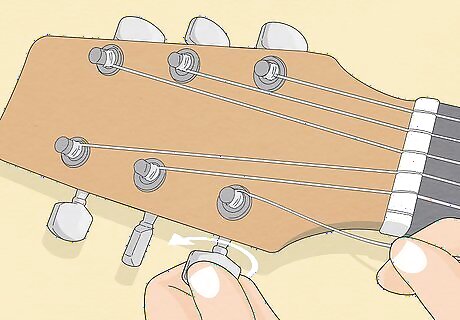
Restring your guitar. Feed the string through the hole in the middle of the tuning peg and pull it tight. Turn the peg counter-clockwise to tighten the string and bring it into tune. When you have the string tuned to the right note, trim off the excess with your wire cutters.




















Comments
0 comment